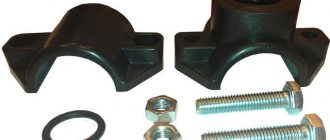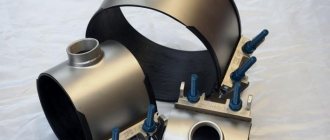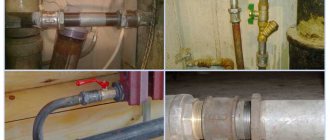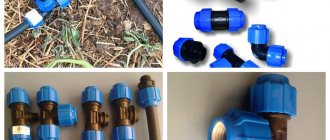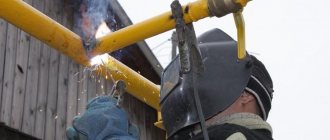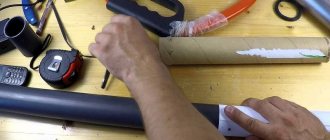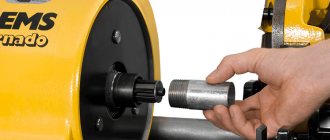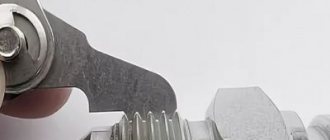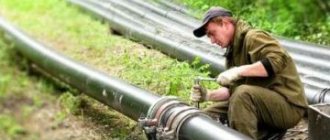If all the work is carried out within an organization that has the appropriate permits and permits, then only the technical part of the work is required, and if there are no such permits, for example, to connect a private house to the gas supply system, then first of all you need to contact the appropriate authorities.
In cases where the inspection authorities detect an illegal tap into the gas pipeline, this will be followed by serious penalties. The person responsible for this action will have to pay in full the cost of the entire volume of gas consumed and the work to dismantle the illegal connection. In some cases, such an insertion can be qualified as a criminal offense, that is, as theft and causing property damage.
Pipeline tapping process
The best illustration of the process of tapping into a pipeline is a video from the company ArmProf, which supplies components for tapping into a pipe under pressure. Equipment for tapping into pipelines is presented on the official website of the Armprof company.
The presented video demonstrates how quick and technologically cutting into a pipe can be. To complete the operation, it was not necessary to dig a huge pit to disconnect consumers.
Let us highlight the main stages of the technological process:
Installation of the clamp
Before installation, make sure that the clamp fully matches the diameter of the pipe in which the tap will be made. The surface of the pipe should be cleaned, then install the clamp and tighten the mounting bolts tightly.
Gate valve installation
The valve is attached to the clamp flange. The valve must seat tightly, this should be checked before drilling.
Installation of drilling equipment
The tapping device is a drill with a cover that is attached to a valve. The tightness of the connection is ensured by seals. Before starting installation, you must check that the drill passes freely through the valve and that it is long enough to make the hole.
Performing the drilling process
After installing the tapping equipment, the pipe is drilled. With correctly selected and installed equipment, the drilling process occurs without significant leaks of liquid from the pipeline. The appearance of a small amount of liquid is possible only when the drill is removed from the valve.
Process description
Connection of metal systems
- Surface cleaning. Remove paint, debris, and rust from the place where you plan to make the insert.
- Marking. Determine where the connection will be and mark it.
- Making holes (with the coil method - 1, with the T-bar method - 2).
- Well treatment. The cracks should be treated with clay, and it is recommended to begin this process while cutting the surface in order to minimize the risk of burning/ignition of leaked blue fuel. The finished holes must be closed as quickly as possible with a special plug (made of asbestos and clay). The treated area must be cooled.
- Installation of disconnecting device. When the metal has cooled, the plug can be opened to remove a fragment of the cut pipe from the structure. After removing the piece of metal, a disconnecting device is placed in the gap, which is a set of disks made of wood and rubber, as well as a bag of viscous clay. If you adhere to the T-bar method, then there will be two such slots.
- Installation of the pipe. When the disconnecting device has covered the gap, it’s time to start making the main hole - for the attached (new pipe). Check that the diameter is correct; it is possible that the markings will have to be corrected. Make a hole and install a pipe. Weld the joints of the pipe on both sides, then close the valve on it.
- Sealing the hole. So, the pipe is welded, now we need to weld a new pipe. To do this, first remove the remaining metal that appeared as a result of making the main gap. Insert them into place, treat them with clay, and brew them too. Check if the weld seam is leaking gas (using soap).
- Connecting a new pipe.
After installation, it is advisable to paint metal structures in order to protect them from corrosion
Insertion into a plastic pipe
Increasingly, plastic structures are being used for installation of utility networks. If you need to connect to such a system, what should you do? First, be glad that the process will not be more complicated than with metal. Secondly, strictly adhere to such recommendations.
Buy high-quality - factory-made connecting elements (fittings) that comply with GOST, ideally metal. Use a socket joint and special glue to improve the reliability of the seam. Make sure that the joint is perfectly sealed and has maximum density. Before installation, treat the insert with an anti-corrosion compound.
How is the insertion itself carried out in the case of plastic nets? The connection is made by creating inserts located perpendicular to the operating system. The length of the inserts can vary between 70-100 cm. The extension should take place using plastic pipes - based on a socket-contact connection. What is this technology? The steel insert is heated (to approximately 60 degrees). And a plastic structure is already placed on it, instantly and with force. If you are cutting into a system with medium pressure, experts advise connecting powdered polyethylene to the “case” in order to make the connection as strong as possible.
This is how you connect to the plastic network
It is, of course, better to cut into a gas pipe with the help of professionals, however, having mastered the theory, you can experiment, meanwhile, it’s up to you to decide.
Advantages of tapping into a pipeline under pressure
- Cost reduction. Since the work does not require blocking the entire supply system, the costs of restarting it are eliminated. The technologies used by our company ensure that the connection can be carried out with a fully functioning network.
- Save time. Eliminating the need to shut down and restart the network reduces the overall work time. Another important factor is the possibility of inserting into the pipeline under pressure at any time of the year and in any weather.
- Comfort for consumers. It is very important that when connecting to utility systems, uninterrupted supply of gas, water or heat to consumers is possible for the entire duration of the work.
- Ecological factor. Pollution of the environment by the transported substance is excluded.
Gas pipeline capacity
When cutting into a city gas pipeline, preliminary work is performed - calculating the throughput. In this case, the purpose of the gas pipeline is of fundamental importance. For domestic needs, a simple low-pressure system is installed. In such conditions, calculations are performed using the simplest formulas, taking into account only the diameter of the pipe and the average pressure in the network.
Qmax = 0.67 DN² * p, where
- Qmax – throughput;
- DN – nominal diameter of the pipe – internal diameter indicated in the documents;
- p – the sum of the working pressure in the gas pipeline and 0.1 MPa.
When calculating, average values are used - pressure surges; the magnitude of the friction force that occurs during movement is not taken into account.
If the connection is made to lines with higher pressure, other parameters must be taken into account. The formula is used: Qmax = 196.386×D²×P/Z×T, where:
- Qmax – maximum throughput;
- D – internal diameter of the gas pipeline;
- P – sum of working pressure and 0.1 MPa;
- Z – gas compressibility coefficient;
- T – temperature of the supplied gas in Kelvin.
From here the dependence of throughput on temperature is clearly visible. To increase this parameter, it is necessary to maintain a stable temperature of the supplied fuel and insulate the gas pipeline.
Joining pipes without welding: general information
There are several ways to connect pipe structures and insert them into the main line. Some of the communications can then be further installed if necessary (in case of repair or emergency work), others are permanent. They cannot be disassembled without destroying the entire structure or a separate section of it.
It is important from the very beginning to strictly follow the instructions for correct insertion into the pipeline, to do everything as stated, so that in the future you do not have to redo everything and buy new material. In principle, there is nothing complicated.
When done carefully, tapping into a pipe will be in no way inferior in quality and reliability to a welded joint. It will be just as airtight and durable.
Before moving directly to the analysis of the rules for cutting into a pipe, debriefing and tips for a beginner, let’s look at the types of pipes.
They are divided into 2 groups:
- Hard (steel, copper, cast iron);
- Flexible (polypropylene, metal-plastic, polyethylene).
Accordingly, depending on the type of pipe, certain joining methods are used that are suitable in a given situation and comply with safety and quality standards. Also, to insert into a pipe you need the appropriate tool, which must be purchased in advance.
Illegal tapping and its consequences
Most often, illegal tapping is carried out by individuals who are disconnected from the gas pipeline for non-payment, or who want to connect a house, garage or any outbuilding without agreeing on the project and paying for both the connection itself and the subsequent use of gas. Depending on how much damage was caused to the gas pipeline during the tapping, the amount of gas used, as well as the consent or non-consent of the guilty party to resolve this issue peacefully and pay all the required fines, administrative or criminal liability may be applied.
In case of causing particularly large damage and unwillingness to compensate for it, as well as when it is revealed that such tappings are not the first time, Articles 158 of the Criminal Code of the Russian Federation (Theft in the public domain) and 165 (Causing damage by deception) may be applied to the perpetrator. ). Therefore, it is better not to take risks and obtain all the necessary permits and conclude the appropriate agreement.
Illegal tapping is almost always carried out in violation of technological standards, which can lead to serious accidents and fires.
What electrodes should be used to weld water pipes?
The best electrodes for welding water pipes under pressure have long been considered:
UONI 13/15 electrodes are universal high-quality electrodes for MMA welding, which make it possible to repair leaking pipes. The weld seam formed by UONI 13/15 electrodes has a high combination of ductility, strength and toughness, which in turn makes it possible to weld fistulas and other damage to water pipes.
MGM-50K electrodes are a relatively new type of electrodes that are optimized for welding pipelines under pressure. The peculiarity of welding with MGM-50K electrodes is that a gas bubble forms around the arc, which can push away steam and even liquid that is not under too much pressure. All this simplifies welding work related to the repair of water pipes, and also makes it possible to carry out repair work on time.
How to weld a pipe without turning off the gas
So that air does not form in the pipe, and they are simply extreme!
so that when welding, scale does not get inside the pipe, which will then ruin the nozzles
on gas equipment. That's why they cook under pressure.
in fact, if you close the tap, air enters the pipe
an explosive mixture results. so they cook by pressure
Duc and b a n e t zhe, it’s not enough to show! kaG boNba!
The question is formulated incorrectly or you are talking nonsense.
What kind of pipe is being welded (main, high, low pressure)? What is boiled in the pipe (Two pipes are connected lengthwise, or welded at an angle)? Which tap is not closed? Regarding your not clearly formulated question from those. unprepared people may form the opinion that you can cook a gas tube with gas passing through it, try it, if after the explosion they find something from your remains, then they will bury something. If the people believed in this fairy tale, then for the elections you can come up with Do you want a test of political strategists? Like they threw a hook, people swallowed it, believed it, now we’ll throw an even bigger tale, let’s see if they believe it or not.
yes anyone can join now
took the pipe and connected. After all, gas does not belong to anyone. it's folk
Source
Cold tapping device
Cold cutting installations are designed for mechanical cutting of holes in pipelines DN 150...1200, which are under pressure of working media up to 6.3 MPa (oil, water, etc.), through shut-off valves installed on the outlet pipe DN 50,100,150,200,300 in explosive zones of class “1” » according to GOST 31610.10-2012 Tools and devices used:
- solid drill bits;
- a combined tool, consisting of an annular drill and a central spiral drill;
- drill diameter d=50 (UHV-50), d=80, d=100, d=120, d=132, d=150 (UHV-150), d=170, d=200, d=225, d= 230, d=250, d=270, d=300 (UHV-300);
- special keys d=36 (UHV-50), d=36, d=50 (UHV-150), d=80, d=100, d=120, d=132, d=150 (UHV-300)
| Specifications | UHV-50 | UHV-150 | UHV-300 |
| Maximum pressure in the cut pipeline, MPa | 6,3 | 6,3 | 6,3 |
| Cutting tool rotation speed, rpm | 33,21 | 49,82 | 49,82 |
| Cutting tool feed, mm/rev | 0,078 | 0,062 | 0,062 |
| Maximum tool stroke, mm | 50 | 100 | 120 |
| Hole cutting time, min, no more | 20 | 40 | 40 |
| Installed power, kW, no more | 1,1 | 2,2 | 3,0 |
| Overall dimensions, mm | 275x666x750 | 1260x670x360 | 1750x785x525 |
| Weight (without electrical equipment and adapters), kg, no more | 60 | 113 | 210 |
| Cutter diameter, mm | 36 | 36*; 80; 120; 132; 150 | 170; 225; 230; 250; 270; 300; 80*; 120*; 132*; 150* |
* with the use of an additional adapter for cutting tools.
The development is protected by patent No. 2147975 dated March 11, 1999.
source
Gas pipe welding technology
Welding of gas pipes is carried out using various technologies: plasma, gas, argon, electric arc. Connections must be of high quality; novices are not allowed to install gas pipelines, only specialists with a personal stamp. The process is regulated by GOST 16037-80 and SNiP III-42-80. The choice of welding method depends on the alloy. Rolled steel and plastic are used for installation. Metal is traditionally used for domestic gas pipelines.
What you need to know before making a tie-in
First you need to mention the bureaucratic aspects and only after that move on to the technical aspects. So, most likely, you will have to obtain permission to tie in. But you can cut into a water pipe without permission, if you are exactly sure what’s what. At the same time, it is worth understanding that administrative and financial liability is provided for illegal tapping.
The second point is related to determining the optimal section of the pipe for insertion into the water supply system. It is best if this is a place where the pipe is laid straight, without bends. Plus, there must be a free approach to the pipeline in order to dig a hole and connect the pipe.
The third point is related to the determination of the necessary materials for inserting into the water supply under pressure. The choice directly depends on what exactly the pipe is made of: polypropylene, steel or cast iron. You also need to know in advance the diameter of the pipe into which the insertion will be made.
Rules for tapping work
When connecting to a gas pipeline under any pressure, strictly follow the following safety rules:
- Tapping into a gas pipe under high or low pressure is carried out only by employees of the relevant organization and only with a certificate confirming their qualifications. This is very dangerous work.
- Connection to a low-pressure network is carried out at values no higher than 20–80 mmHg. To do the same at high or medium pressure, you must first reduce the value to an acceptable one. Switching devices are used, and a bypass is installed in dead-end gas pipelines.
- If the pressure cannot be reduced, specialized equipment is used. Such work is much more difficult and expensive.
- When welding or gas cutting, it is necessary to maintain the pressure in the work area in the range from 40 to 150 kg/cm.
With strict compliance with safety regulations, the likelihood of accidents and emergency situations is reduced to a minimum.
Metal pipe connection
It is important to decide on the optimal tapping method so that there are no problems with the operation of the pipeline in the future.
If you look at the photo of how to cut into a pipe, and examine it in detail from the side, you will notice that the connection is being made:
- At right and acute angles;
- Located to the side or up.
This type is not due to the desire to achieve an aesthetic perception of the entire structure, but to expediency: this makes it much easier to use the pipeline in the future.
As for connecting metal pipes, they are:
- Threaded (assembly of a non-pressure system - drainage or chimney made of stainless steel);
- Flanged (truncated cone (ring) with a rubber gasket, with holes for bolts or studs);
- Using crimp rings (couplings, sleeves), which are tightly pressed.
Tapping into plastic and metal-plastic pipes is much easier. Difficulties may arise in the process of joining polymer structures with metal ones.
Flexible pipes may become deformed. Therefore, you need to be careful and carefully carry out all work on joining structures from materials of different hardness and other technical characteristics.
Types of gas pipelines and insertion methods
A gas pipeline is a structure whose direct purpose is to transport gas through a pipeline. Depending on the purpose of the gas pipeline, natural gas can be supplied at different excess pressures. So, for example, main pipelines (transmitting gas over long distances) are only of high pressure, and distribution pipelines (delivering gas to the final consumer): low, medium and high pressure.
Tapping into a gas pipeline under pressure without stopping gas transportation along the main pipeline can be used both when repairing the pipeline and when connecting individual consumers. At the same time, the pipeline operates without interruption, and the pressure and supply volume do not decrease. This method is also called cold tapping. In addition, there is a more “traditional” method - pipe welding, which is considered very labor-intensive and requires highly qualified and special access for the welder.
Modern technologies make it possible to insert into a gas pipeline without releasing pressure, but the process itself may differ depending on the material of the pipes, which can be plastic or metal. Plastic gas pipelines are gradually gaining popularity due to their high performance and the ability to be laid in the most unfavorable conditions.
Insertion into a plastic gas pipeline under pressure
To create bends and other tie-in elements into a finished system, it is advisable to use shaped parts, or fittings, that are factory produced and comply with GOST, in order to reduce the risk of emergency situations in the future. Basically, metal fittings are used for inserting into plastic pipes using a socket connection, which, after installation is completed, is glued with special compounds.
The adhesive joint must have maximum density and be completely sealed so that moisture does not leak through it. The steel insert itself must be treated with compounds that protect against rust, since moisture ingress and corrosive processes can lead to the appearance of cavities and peeling of the vinyl plastic in the joint area.
Direct insertion is carried out by creating inserts from steel alloys perpendicular to the gas pipe. Each insert should have a length of 70 to 100 cm and be extended with plastic pipes using a socket-contact connection. This method implies that a plastic pipe is pressed onto a steel insert heated to a temperature of around 60 °C. This method is used to create bends from gas pipelines with low pressure, and for medium ones, before building up a steel insert, it is necessary to apply powdered polyethylene to the site of the future connection for a tighter adhesion of the two types of material.
Insertion into a gas pipeline made of metal pipes
Despite the development of plastic pipeline technologies, the most common option is still a gas pipeline made of steel pipes.
When installing main and distribution gas pipelines, welding is another main type of connection. Pipelines whose pressure is more than 70 kPa are welded in compliance with strict rules put forward by Gosgortekhnadzor. Only those welders who have undergone appropriate training and have a permit are allowed to perform this work.
Pipe welding and its technology also largely depend on the material of the structure being welded, but all of them are mainly butt welded. Welded joints and types of seams are strictly designated by GOST and must be performed only in accordance with these requirements. These standards provide not only the type of seam, but also its size and the location of parts at different angles.
In accordance with this, the types of welds will be determined:
- butt;
- T-bar;
- overlap;
- angular.
Particular attention is paid to corner and T-shaped (T-shaped) inserts, since it is very important here to avoid poor penetration of seams and undercuts.
Before welding, gas pipes must be carefully prepared: cleaned of rust and dirt, oxides and oil. The type of welding itself does not matter for a gas pipeline, so both arc and laser welding are used.
Without releasing the pressure in the main pipe, tapping into a metal gas pipeline can be done through a valve or using a special device called a PGVM.
If the option with a valve is used, then in this case a coupling and a pipe with a flange are welded to the main pipe, to which the valve with a chamber is attached. A hole in the pipe is cut with a cup cutter through the coupling, after which the cut fragment, as well as the rod itself with the cutter, is removed through the chamber and the valve is closed. After this, the outlet can be connected to the flange located on the valve. The disadvantages of this method include the need to install wells, as well as the inconvenient location of the valve to the main pipe, which makes operation less convenient.
The second method is the use of a PGVM, a special device that is designed to insert into existing gas pipelines without releasing pressure, having a pipe diameter from 186 to 529 mm. This device carries out insertion by creating holes of 80 and 140 mm in the wall of the gas pipe. First of all, a pipe is welded to the gas pipe, which should have a diameter equal to the diameter of the connected outlet, inside of which the sleeve is welded to the pipe wall. A pin and a rod with a cutter are screwed into the bushing and machine oil is poured in so that it exceeds the level of the pipe by 3 mm.
A PGVM device with a drive for a cutter is installed on the connection flange, which cuts a hole in the pipe of the required size. After which the cut fragment is removed, the drive, rod and cutter are removed, instead of which a threaded plug is installed and the entire system is returned to its place. Then the gas opens, the plug is wrapped in the pipe, the PGVM device is removed and the threaded plug is scalded around the perimeter. Upon completion of the work, the quality of the welds is checked using a soap emulsion, and the gas pipeline itself and the insert are reliably insulated.
Tapping into a gas pipeline, like any work related to gas mains, requires the strictest adherence to safety regulations. Insertion should be carried out only by qualified specialists with clearance for this type of work.
Gas has a responsible mission - to ensure that we do not freeze or starve. Meanwhile, he himself does not come to visit, for example, like the wind or the sun, gas must be properly “invited”, a green corridor must be organized for him and reliable “transport” must be provided. Let's look at how to crash into a gas pipe according to the letter of the law and like a hooligan - for those who like to tickle their nerves by breaking the rules.
MIG/MAG welding
Metal Inert/Active Gas technology provides for the creation of a protective atmosphere over the working area. Welding of gas pipes using the MIG/MAG method is used for rolled carbon steels; it involves feeding filler wire and melting it under the influence of an electric arc. The protective atmosphere prevents oxidation of the melt. In inverter semi-automatic machines, the filler wire acts as a conductive electrode. The gas supply is regulated by a reducer or flow meter. Welding methods:
- manual - the welder supplies the additive into the weld pool independently (the simplest and most cost-effective option for performing welding work);
- in semi-automatic mode, the additive is supplied through a gun at an adjustable speed (working with inverter equipment requires certain skills, the ability to control the seam);
- when using automatic machines, the filler wire feed speed is fixed (expensive equipment is used).
Tapping methods without welding
You can cut into a main pipeline without using welding. This technology is used by many specialists, since welding work requires compliance with safety rules. In this case, special equipment will be required for welding. Welding work is considered complex and time-consuming.
Non-welding tapping technologies include:
- installing a collector is the optimal solution for a large private house. The compact collector system is also installed in the apartment. A water pipe is installed at the entrance of such a system. The collector has several outputs. Their number depends on the system model. The pipeline is connected to any outlet. Adapters are used to fix the hoses;
- installation of a tee - this insertion method is used if a single outlet is provided. The water supply connection is first unscrewed, and then a tee is installed in this place. The pipeline is expanded or shortened by cutting threads;
- the process of cutting the pipe itself - the technique is optimal if there is no external connection. A grinder is used to perform cutting. A tee with a pre-cut thread is installed;
- the use of a thin pipe - a hole is prepared in the system onto which a seal or clamp is fixed. To install the outlet, tightening screws are used.
No pressure
To insert a pipe into a HDPE pipe without pressure, it is necessary to use saddle bends without a cutter.
To insert into a HDPE water pipe, it is recommended to use a compression saddle, which is secured with bolts. The compression saddle pipe has an internal thread into which a ball valve or coupling is screwed to connect to a HDPE pipe. The seal is achieved using a standard rubber ring, which is firmly pressed when tightening the bolts. A hole in the support pipe is drilled using a drill.
Let's move on to step-by-step instructions:
- clean the surface;
- insert the o-ring (gasket);
- we put two half-clamps on the pipe;
- secure them with mounting bolts;
- we stretch the fastening connections so that the clamps close together;
- we drill a hole that goes into the tee of the clamp using a drill;
- install the saddle using the seal.
Electric welded saddle
Electric-welded HDPE pipe saddles are installed using a built-in heating element, which melts the plastic base. The molten base becomes liquid, and when solidified, it forms a reliable monolithic connection with the supporting pipe. Rotation 360 degrees around its axis makes it possible to accurately install the part, and indicators built into modern electric welding saddles facilitate the process of electrodiffusion welding of the structure.
When installing, you need to find a flat section of a water supply or other HDPE pipe, thoroughly clean it of possible contaminants and degrease it.
The electric welded saddle must similarly be prepared for work. After completing the preparatory work, you can carry out welding, and after it, cut in using the screwing method from the side of the main part of the milling element. After welding is completed, the cutter is returned to its original position, and a cover is installed in the hole.
Electric welding deal drawing
Crimp clamp
A lightweight analogue of an electric welded saddle is a crimp clamp. There are the following types of clamps (linings) for inserting into HDPE pipes:
- with shut-off valve;
- with a built-in cutter, with a safety valve for inserting HDPE pipes;
- with a flanged or threaded metal end;
- with a plastic end.
In order to insert into a HDPE pipe, the clamp must be put on the pipe and secured to it with bolts. After this, drilling is done through the outlet pipe and the outlet itself is attached.
You should not drill holes without first installing a clamp or saddle on it, as you can make a mistake with the diameter of the drill. It is optimal to drill through the branch pipe of a fitting already installed for the branch. So the diameter of the drill will be slightly smaller than the internal cross-section of the embedded outlet and you will install it in the required place.
Photo of the pipe insert
Rules for determining the insertion location
Typically, the connection to the water supply is made in the nearest inspection well on a straight section. The basic rule is that the outlet pipe must be laid below the freezing level of the soil. For middle latitudes it is 1.2-1.5 meters. But the trenches should be about half a meter deeper, since a drainage layer of sand and gravel will have to be constructed.
In some cases, the pipeline is additionally insulated with foam plastic materials, and a heating cable is installed with automatic switching on at a temperature of 0-+2 degrees.
The water supply branch is equipped with a drain valve installed directly behind the tap.
Before you start digging a trench, you need to make sure that it does not intersect with other communication systems - communication cables, power supply or sewerage.
Joining of profile pipes
The most affordable way to connect profile pipes is by installing fastening clamps. Using these simple devices, it is convenient to assemble any type of small-sized metal structures, erecting canopies and shelving, greenhouses and fences, canopies and modular partitions.
The use of fastening clamps makes it possible to ensure the connection of pipeline elements, the stability and strength of which is not inferior to welded
The undeniable advantage of using fasteners is ease of installation and the ability to disassemble the assembled structure an unlimited number of times.
To implement this method you will need only three components:
- Rolled pipes cut to size.
- Required number of fastening clamps.
- Wrench.
Crab clamps can be “X”, “G” and “T”-shaped elements, with the help of which it is convenient to join straight sections of pipes, corner structures and simultaneously connect up to four segments within one unit.
When assembled, they have the shape of a square or rectangle, the sides of which tightly fit the joined parts of the metal pipes.
Crab clamps are made from galvanized or powder-painted sheet metal having a thickness of 1.5 mm
Fastening with crabs should not cause any particular difficulties. Anyone can insert the cut pipes into the clamp and secure the clamping sticks by tightening the bolts on the system.
But this method can only be used for profile pipes with a cross-section of no more than 20 x 20 mm, 20 x 40 mm and 40 x 40 mm. In addition, joining of elements can only be done at right angles.
You can connect square pipes without welding by installing fittings of a given profile.
For joining and inserting pipes, an adapter coupling is used, the diameter of which is one unit larger than the cross-section of the structural elements being joined
There are several types of fasteners in the form of fittings:
- Couplings - at joints on straight sections.
- Crosses and tees - for installation in branching areas;
- Elbows and turns – if it is necessary to change the direction of the pipeline.
With the help of fittings, you can obtain a fixed fastener, the only vulnerable point of which is the susceptibility to corrosion, which is typical for the ends of the joined elements inserted into it.
This situation occurs as a result of the accumulation of condensate inside the fastener. It will cause rusting if the metal pipes are not treated with an anti-corrosion compound.
The cost of tapping into a water supply system
The price tag for a polymer clamp is 100–250 rubles. In this case, a fitting installed on a pipe with a diameter of 32 mm will cost 100 rubles, and for 75 mm fittings – 250 rubles.
The cost of a stainless steel clamp, complemented by a flange outlet, is 9–10.5 thousand rubles. The delivery set of this equipment includes a rubber gasket and 6 studs that provide the ability to fix the staples.
Electric welded saddles produced by the Italian company Eurostandard Spa, having a diameter of 40–250 mm, can be purchased for 25–80 euros. As for the cost of work, the average price tag for services of this type ranges from 2 thousand to 2.5 thousand rubles.
Testing and adjusting water pressure
Pressure tapping into plumbing equipment is the final stage of its installation. The purpose of such an event is to check the quality of the connections made during assembly.
To do this you need to perform the following steps:
- Fill the water supply completely with water. To do this, you need to open all several taps in the house so that you can bleed air from the system. In addition, an automatic valve must be installed in a normally designed water supply system to remove air.
- Measure the water pressure at the location where the outlet pipe is inserted. For water supply in areas with low-rise buildings, it is maintained within 1.5-2.8 atmospheres.
- It must be taken into account that some types of household appliances and plumbing equipment can only operate at a minimum pressure of 4 atmospheres, otherwise they either do not turn on or quickly fail. Obviously, the inside of the house water supply must reliably withstand a load of at least 4.5 atmospheres.
- After filling the water supply network with water, the supercharger is connected, and the pressure in the system increases to 6 atmospheres. At the same time, all connections are inspected to identify leaks at its connections. The load continues for at least an hour.
How to make a branch from the highway
Having inserted the pipe using one of the methods, the outer pipe from the main is placed in the finished trench, and the branch is connected to the valve using a crimp coupling. The embedded water supply starts at the valve located on the clamp and ends at the water flow meter. The water meter should be located between the two valves.
Attention! An even meter can be installed inside a well or inside a house. The metering device is equipped with a check valve to prevent liquid from flowing in the opposite direction.
If the outlet pipe passes through the wall of the building, then there should be a distance of 20 centimeters between the wall and the structure. After installation is completed, this gap is removed using a resin strand, or sealed using waterproof seals. Next, the work is masked with cement.
The metering device is equipped with a check valve to prevent liquid from flowing in the opposite direction. If the outlet pipe passes through the wall of the building, then there should be a distance of 20 centimeters between the wall and the structure. After installation is completed, this gap is removed using a resin strand, or sealed using waterproof seals. Next, the work is masked with cement.


